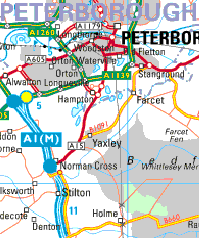Stilton Cheese
Information about Stilton Cheese plus stilton cheese recipe collection
|
Â
Ingredient
of the
MonthÂ
 |
Scroll
down for Stilton Recipes
|
January
2002 |
Click
here for previous Ingredients of the Month
Â
 Known
as �The King of Cheeses�, Stilton is one of the few British
cheeses granted the status of a �protected designation origin� by the
European Commission. Known
as �The King of Cheeses�, Stilton is one of the few British
cheeses granted the status of a �protected designation origin� by the
European Commission.Â
Whilst
it is an excellent eating cheese (Stilton and Port is a delight which should be
savoured by all at some time during their life) Stilton is also a wonderful
cheese for using in recipes, a selection of which are featured below.
Origins and History
of Stilton Cheese

Â
Stilton takes its name from the village of
Stilton in Cambridgeshire, England (about 80 miles north of London).Â
In
the 18th century, the town of Stilton was a staging post for coaches. Travellers
journeying from London to York would break their voyage there to refresh not
only themselves, but more importantly, the horses. A Mr Cooper Thornhill who was
landlord at the Bell Inn at Stilton, introduced the weary travellers to
this creamy, blue-veined delight and it is thought that he purchased the cheese
from a farmer's wife called Mrs Frances Pawlett, although it's likely the
original cheese bore little resemblance to the blue Stilton cheese
produced nowadays.
Â
How
Stilton cheese
is made
 Only
cheese produced in the three counties of Derbyshire, Leicestershire and
Nottinghamshire in England can be called Stilton and it must be made according
to a strict code . Only
cheese produced in the three counties of Derbyshire, Leicestershire and
Nottinghamshire in England can be called Stilton and it must be made according
to a strict code .
Stilton is made
from fresh pasteurized cows' milk to which acid forming bacteria (starter
cultures), a milk clotting agent (such as rennet) and �penicillium roqueforti�
(blue mold spores) are added. Once the curds have formed, the whey is removed
and the curds allowed to drain overnight. The following day, the curd is then
cut into blocks to allow further drainage before being milled and salted. Each
cheese requires about 11kg/24 lb of salted curd which is placed into cylindrical
moulds. The moulds are then placed on boards and turned daily to allow natural
drainage for 5 or 6 days. As the cheese is never pressed, it creates the flaky,
open texture.Â
After 5 or 6
days, the cylinders are removed and the coat of each cheese is sealed by
smoothing or wrapping to prevent any air entering the inside of the cheese.
After 6 weeks of regular turning, the cheese has formed a crust and is then
pierced with stainless steel needles which allows air to enter the body of the
cheese and create the blue veins.
It can be sold
at about 9 weeks and at that point weighs about 8kg/17lbs.
Â
|

 Known
as �The King of Cheeses�, Stilton is one of the few British
cheeses granted the status of a �protected designation origin� by the
European Commission.Â
Known
as �The King of Cheeses�, Stilton is one of the few British
cheeses granted the status of a �protected designation origin� by the
European Commission. 
 Only
cheese produced in the three counties of Derbyshire, Leicestershire and
Nottinghamshire in England can be called Stilton and it must be made according
to a strict code .
Only
cheese produced in the three counties of Derbyshire, Leicestershire and
Nottinghamshire in England can be called Stilton and it must be made according
to a strict code .